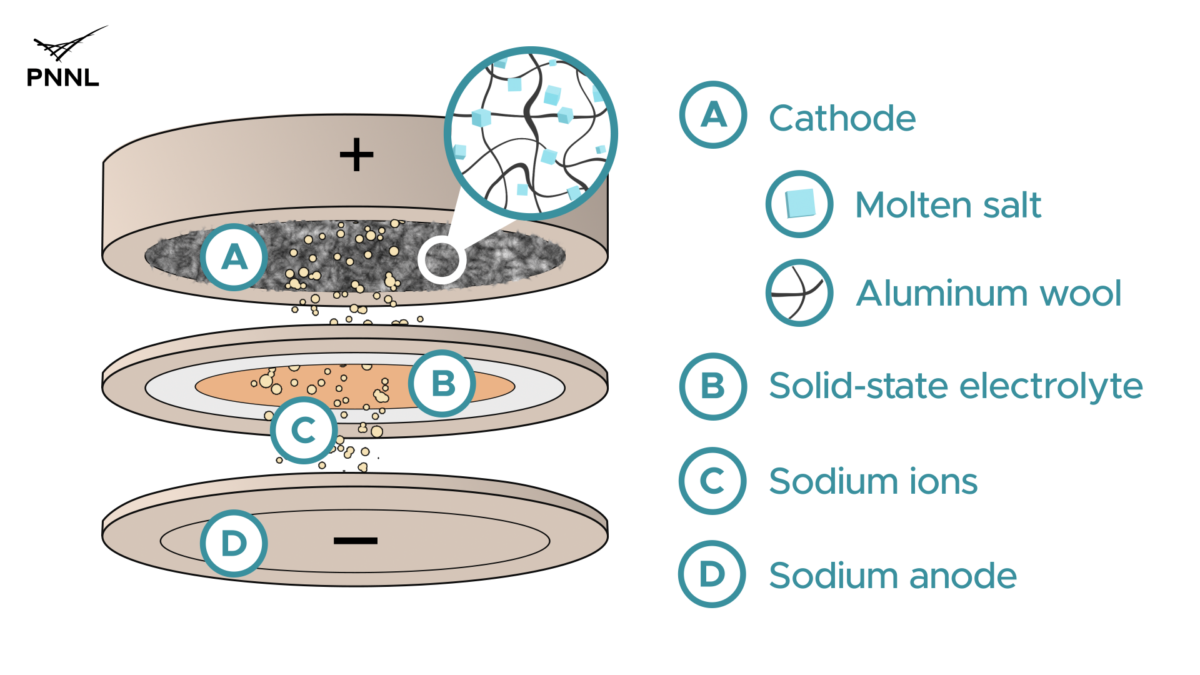Scientists from the US Department of Energy’s Pacific Northwest National Laboratory (PNNL) have designed a molten salt battery based on an anode made of molten sodium (Na) and a cathode made of aluminum (Al) and sodium tetrachloroaluminate (NaAlCl4).
They described the novel battery as a low-cost, grid-scale solution for long-duration renewable energy storage and said the use of NaAlCl4 offers extra accessible capacity hidden in acidic chloroaluminate. They said the proposed battery chemistry relies on the sixth and second most abundant elements on Earth.
“This enables higher specific capacity and average discharge voltages than previous Na-Al batteries, utilizing two distinct cell reaction mechanisms in one battery,” the researchers said, noting that this second reaction, on top of the neutral molten salt reaction, is the crucial factor for the device's higher voltage and capacity. “Specifically, after 345 charge/discharge cycles at high current, this acidic reaction mechanism retained 82.8 percent of peak charge capacity.”
The researchers assembled Na-Al full cells in the discharged state in a nitrogen-filled glovebox. They then closed the cells with stainless steel endcaps and sealed them hermetically by tightening a set of eight screws in a star pattern.
“The system design allows only sodium to move through the solid-state electrolyte to charge the battery,” they explained. “This flat cell design allows the cell capacity to be increased by simply using a thicker cathode, which we leveraged in this work to demonstrate a triple capacity cell with sustained discharge of 28.2-hours under laboratory conditions.”
Th research group found that the battery achieves a high areal capacity cell of 138.5 mAh cm−2 at a high current density of 4.67 mA cm−2. The scientists said the battery could potentially achieve an energy density of up to 100 Wh/kg at a cost of $7.02 kWh.
“We have eliminated the need for nickel, a relatively scarce and expensive element, without sacrificing battery performance,” said Li. in reference to another advantage offered by the new battery design. “The aluminum cathode charges more quickly, which is crucial to enable the longer discharge duration demonstrated in this work.”
They presented the battery tech in “Unlocking the NaCl-AlCl3 phase diagram for low-cost, long-duration Na-Al batteries,” which was recently published in Energy Storage Materials.
“We showed that this new molten salt battery design has the potential to charge and discharge much faster than other conventional high-temperature sodium batteries, operate at a lower temperature, and maintain an excellent energy storage capacity,” said researcher Guosheng Li.
This content is protected by copyright and may not be reused. If you want to cooperate with us and would like to reuse some of our content, please contact: editors@pv-magazine.com.




3 comments
By submitting this form you agree to pv magazine using your data for the purposes of publishing your comment.
Your personal data will only be disclosed or otherwise transmitted to third parties for the purposes of spam filtering or if this is necessary for technical maintenance of the website. Any other transfer to third parties will not take place unless this is justified on the basis of applicable data protection regulations or if pv magazine is legally obliged to do so.
You may revoke this consent at any time with effect for the future, in which case your personal data will be deleted immediately. Otherwise, your data will be deleted if pv magazine has processed your request or the purpose of data storage is fulfilled.
Further information on data privacy can be found in our Data Protection Policy.